Publications and Information Products
NCHS Data Brief
Number 5, April 2008
Breastfeeding in the United States: Findings from the National Health and Nutrition Examination Survey, 1999-2006
Margaret M. McDowell, M.P.H., R.D.; Chia-Yih Wang, Ph.D.; and Jocelyn Kennedy-Stephenson, M.S.
PDF version 500 KB
Page Content
Key findings
Have breastfeeding rates in the United States changed
over time?
Are children from some population subgroups more likely to
be breastfed than others?
Do breastfeeding rates differ by other sociodemographic
characteristics?
Has there been a change in the United States in the
proportion of infants who are still breastfed at 6 months of age?
Summary
Definitions
Data source
and methods
About the
authors
References
Key findings
Data from the National Health and Nutrition Examination Surveys- The percentage of infants who were ever breastfed increased from 60% among infants who were born in 1993-1994 to 77% among infants who were born in 2005-2006.
- Breastfeeding rates increased significantly among non-Hispanic black women from 36% in 1993-1994 to 65% in 2005-2006.
- Breastfeeding rates in 1999-2006 were significantly higher among those with higher income (74%) compared with those who had lower income (57%).
- Breastfeeding rates among mothers 30 years and older were significantly higher than those of younger mothers.
- There was no significant change in the rate of breastfeeding at 6 months of age for infants born between 1993 and 2004.
Human milk is the ideal food for most infants. Breastfeeding benefits infants and their mothers (1). Breastfed infants receive anti-bodies from breast milk, which protect against infection in the early postpartum period, and breastfeeding is less expensive than formula feeding. This report summarizes information on breastfeeding rates in the United States based on data from the 1999-2006 National Health and Nutrition Examination Surveys (NHANES). Results are reported for the total U.S. population and three race-ethnic groups by birth year cohort.
Keywords: Breastfeeding - Prevalence - Trends - National Health and Nutrition Examination Survey
Have breastfeeding rates in the United States changed over time?
Breastfeeding rates have increased in the United States.
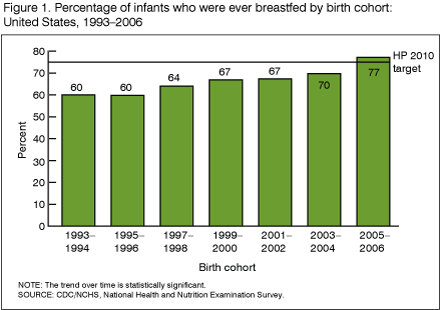
Breastfeeding rates in the United States increased significantly between 1993 and 2006. The percentage of infants who were ever breastfed increased from 60% among infants born in 1993-1994 to 77% among infants born in 2005-2006.
For infants born in 2005-2006, the percent who were ever breastfed exceeded the Healthy People 2010 target of 75% (2).
Are children from some population subgroups more likely to be breastfed than others?
Mexican American and non-Hispanic white children were significantly more likely to have been breastfed compared with non-Hispanic black children in each birth year cohort.
In the 2005-2006 birth cohort group, 65% of non-Hispanic black infants were breastfed compared with 80% of Mexican American and 79% of non-Hispanic white infants.
Although breastfeeding rates were significantly lower among non-Hispanic black infants, significant increases in breastfeeding rates have occurred in this group.
The percent of non-Hispanic black infants who were ever breastfed increased from 36% for those born in 1993-1994 to 65% for those born in 2005-2006.
The observed increases in breastfeeding rates for non-Hispanic white and Mexican-American infants were not statistically significant.
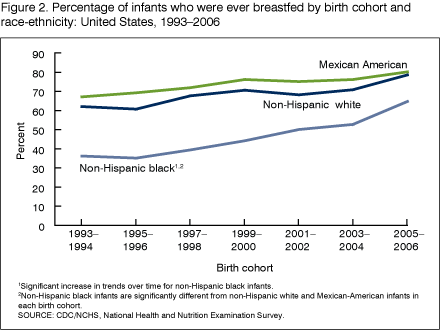
Do breastfeeding rates differ by other sociodemographic characteristics?
Breastfeeding rates were lower for infants in low income families.
Breastfeeding rates were examined by income status group. Income status was defined using the poverty income ratio (PIR), an index calculated by dividing family income by a poverty threshold that is specific for family size (3). Low income was defined as PIR less than or equal to 1.85, and high income was defined as PIR greater than 1.85. For the total population, the proportion of infants who were ever breastfed was lower among infants whose families had lower income (57%) compared with infants whose families had higher income status (74%).
The differences in breastfeeding rates by family income status were only observed among non-Hispanic white and non-Hispanic black infants, but not among Mexican-American infants.
Within each income group, the breastfeeding rates for non-Hispanic black infants were significantly lower compared with the breastfeeding rates among non-Hispanic white and Mexican-American infants.
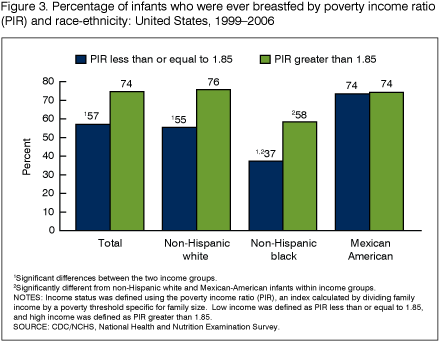
Infants whose mothers were younger were less likely to have been breastfed.
Breastfeeding rates increased significantly with increasing maternal age overall and for all race-ethnicity groups. The breastfeeding rates of mothers who were under 20 years of age (43%) were lower compared with mothers who were 30 years and older (75%) or 20-29 years of age (65%).
Within maternal age groups, there were race-ethnicity differences in breastfeeding rates. Mexican-American infants who were born to mothers who were less than 20 years of age had a significantly higher breastfeeding rate (66%) compared with non-Hispanic white (40%) and non-Hispanic black infants (30%). Non-Hispanic black infants whose mothers were 20-29 years or 30 years and older were significantly less likely to be breastfed than their non-Hispanic white and Mexican American counterparts.
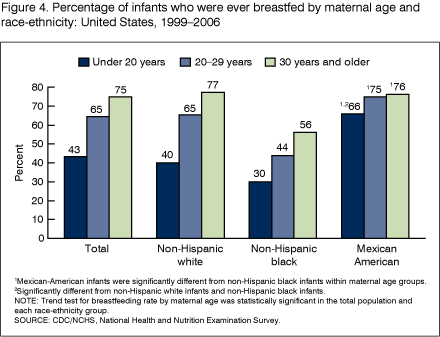
Has there been a change in the United States in the proportion of infants who are still breastfed at 6 months of age?
There was no significant change in the rate of breastfeeding at 6 months of age for infants born between 1993 and 2004.
The rates of breastfeeding at 6 months of age were computed for each birth year cohort using information from NHANES 1999-2004 for infants 6 months of age and older. The NHANES 2005-2006 data were not included in the analysis because the sample size for the birth year cohort was too small to produce reliable estimates.
Overall, the rates of breastfeeding at 6 months of age were significantly higher among Mexican-American (40%) and non-Hispanic white infants (35%) compared with non-Hispanic black infants (20%), but the rates for Mexican-American and non-Hispanic white infants were not significantly different.
The Healthy People 2010 target goal for breastfeeding at 6 months of age is 50% (2). None of the race-ethnicity groups achieved the target goal.
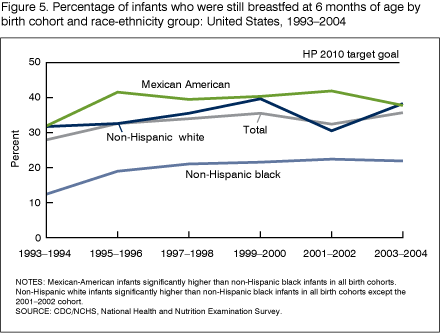
Summary
Breastfeeding rates in the United States have increased significantly among infants born between 1993-1994 and 2005-2006. In 2005-2006 the rates of breastfeeding exceeded the Healthy People 2010 goal of 75%. The rates of breastfeeding at 6 months of age did not achieve the Healthy People 2010 target goal of 50% (2). Breastfeeding rates were associated with race-ethnicity, maternal age, and family income status, thus underscoring the need to continue breastfeeding promotion and intervention activities that target diverse populations.
Diet is an integral component of infant and child growth and development, and healthy feeding practices have benefits that continue into childhood and adolescence. Breastfeeding benefits mothers and babies. Information on breastfeeding is posted on the HHS Blueprint for Action on Breastfeeding website (4).
Definitions
Breastfeeding was defined as ever having been breastfed or received breast milk.
Ever breastfed was defined by the following question: "Was {name of the infant/child} ever breastfed or fed breast milk?" The question was part of the Diet Behavior and Nutrition (DBQ) section of the NHANES household questionnaire (5).
Breastfed at 6 months was defined by the following question: "How old was {name of infant/child} when {he/she} completely stopped breastfeeding or being fed breast milk?" The question was part of the Diet Behavior and Nutrition (DBQ) section of the NHANES household questionnaire (5). All infants and children 6 months of age and older were included in the analysis. Infants and children who stopped breastfeeding or being fed breast milk after 6 months of age were considered to be breastfed at 6 months of age.
Poverty status was defined using the poverty income ratio (PIR) criterion (3). A PIR cut-point of 1.85 was chosen because this is the income cut-point used to determine eligibility in The Special Supplemental Nutrition Program for Women Infants and Children (WIC) (6).
Data source and methods
NHANES is a continuous survey of the civilian, noninstitutionalized U.S. population. The survey is conducted to assess the health and nutritional status of the U.S. population. Survey participants are asked to complete household interview and health examination components. The annual interviewed and examined samples include approximately 5,000 persons of all ages. In 1999-2006, non-Hispanic blacks, Mexican Americans, adolescents 12-19 years, adults 60 years and older, and persons with low income were oversampled to improve the reliability of the statistical estimates for these groups.
This report is based on an analysis of household interview data. English and Spanish language questionnaires were used. A proxy respondent, usually one of the child's parents, answered the breastfeeding and infant feeding questions for infants and children from birth through 6 years of age.
Birth cohort groups, which were based on date of birth were created for each 2-year survey period. The sample sizes for each of the birth cohorts are as follows:
| Birth Cohort Group | 1993-1994 | 1995-1996 | 1997-1998 | 1999-2000 | 2001-2002 | 2003-2004 | 2005-2006 |
|---|---|---|---|---|---|---|---|
| Sample size |
369 |
793 |
1,409 |
2,040 |
1,641 |
1,182 |
434 |
The survey sample weights were used for all analyses. The sample weights account for the differential probabilities of selection, nonresponse, and noncoverage. The weights are incorporated into the estimation process. The standard errors of the percentages were estimated using Taylor series linearization, a method that incorporates the sample weights and sample design.
Differences between groups were evaluated using a univariate t-statistic. Trend tests were done to evaluate changes in the estimates over time. All significance tests were two-sided using p <0.05 as the level of statistical significance. All comparison findings reported are statistically significant unless otherwise indicated. All data analyses were performed using the statistical packages SAS version 9.1 (SAS Institute, Cary, N.C.) and SUDAAN version 9.0 (RTI, Research Triangle Park, N.C.).
About the authors
Margaret A. McDowell and Chia-Yih Wang are with the Division of Health and Nutrition Examination Surveys, National Center for Health Statistics, Centers for Disease Control and Prevention. Jocelyn Kennedy-Stephenson is with Northrop Grumman under contract to the National Center for Health Statistics, Centers for Disease Control and Prevention.
References
- American Academy of Pediatrics Policy. Statement on breastfeeding and the use of human milk. Pediatrics 2005; 115(2), 496-506. Available from: http://www.healthychildcare.org/pdf/BFPolicy.pdf [Accessed 2/20/08].
- U.S. Department of Health and Human Services. Healthy People 2010. Washington, DC: U.S. Department of Health and Human Services. 2000. Available from: http://www.healthypeople.gov/document/html/objectives/16-19.htm [Accessed 2/20/08].
- U.S. Census Bureau. Poverty thresholds for 2006 by size of family and number of related children under 18 years. 2007. Available from: http://www.census.gov/hhes/www/poverty/threshld/thresh06.html [Accessed 2/20/08].
- U.S. Department of Health and Human Services. HHS blueprint for action on breastfeeding. Washington, DC: U.S. DHHS, Office of Women's Health. 2000. Available from: http://www.cdc.gov/breastfeeding/pdf/bluprntbk2.pdf [Accessed 2/20/08].
- Centers for Disease Control and Prevention. National Center for Health Statistics. National Health and Nutrition Examination Survey Questionnaire Data. Diet behavior and nutrition (DBQ) section. Hyattsville, MD: U.S. Department of Health and Human Services, Centers for Disease Control and Prevention, 1999-2006. Available from: http://www.cdc.gov/nchs/about/major/nhanes/datalink.htm [Accessed 2/20/08].
- U.S. Department of Agriculture. The Special Supplemental Nutrition Program for Women, Infants, and Children (WIC). Nutrition program facts. Available from: http://www.fns.usda.gov/wic/WIC-Fact-Sheet.pdf [Accessed 2/20/08].
Suggested citation
McDowell MA, Wang C-Y, Kennedy-Stephenson J. Breastfeeding in the United States: Findings from the National Health and Nutrition Examination Surveys 1999-2006. NCHS data briefs, no. 5, Hyattsville, MD: National Center for Health Statistics. 2008.
Copyright information
All material appearing in this report is in the public domain and may be reproduced or copied without permission; citation as to source, however, is appreciated.
National Center for Health Statistics
Director - Edward J. Sondik, Ph.D.
Acting Co-Deputy Directors - Jennifer H. Madans, Ph.D., and Michael H. Sadagursky
Page Last Modified: September 11, 2008
Data Source: CDC/National Center for Health Statistics
National Center for Health
Statistics
3311 Toledo Road
Hyattsville, MD 20782
Phone:
1-800-232-4636
cdcinfo@cdc.gov
Centers for Disease Control and Prevention, 1600 Clifton Rd, Atlanta, GA 30333, U.S.A
Tel: (404) 639-3311 / Public Inquiries: (404) 639-3534 / (800) 311-3435